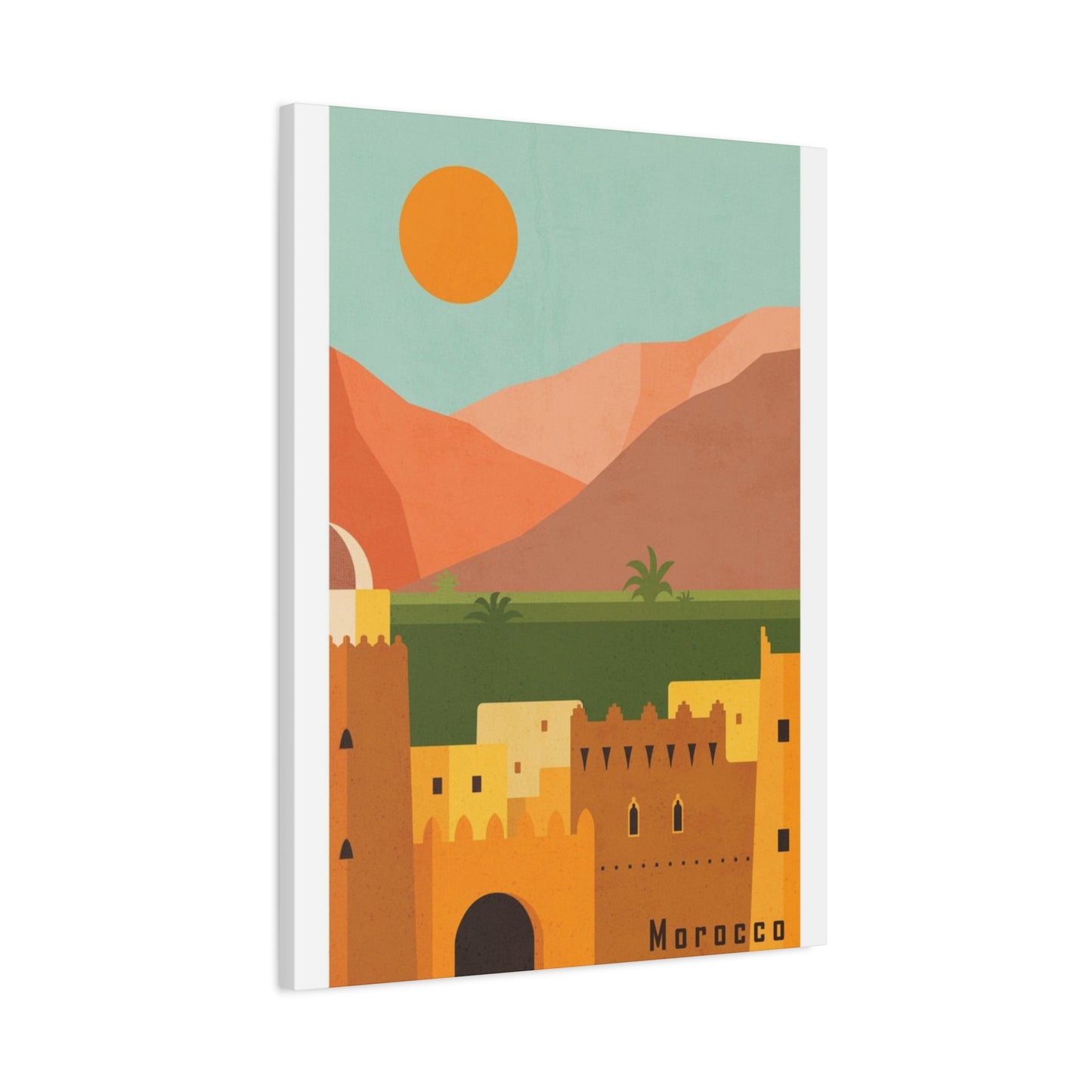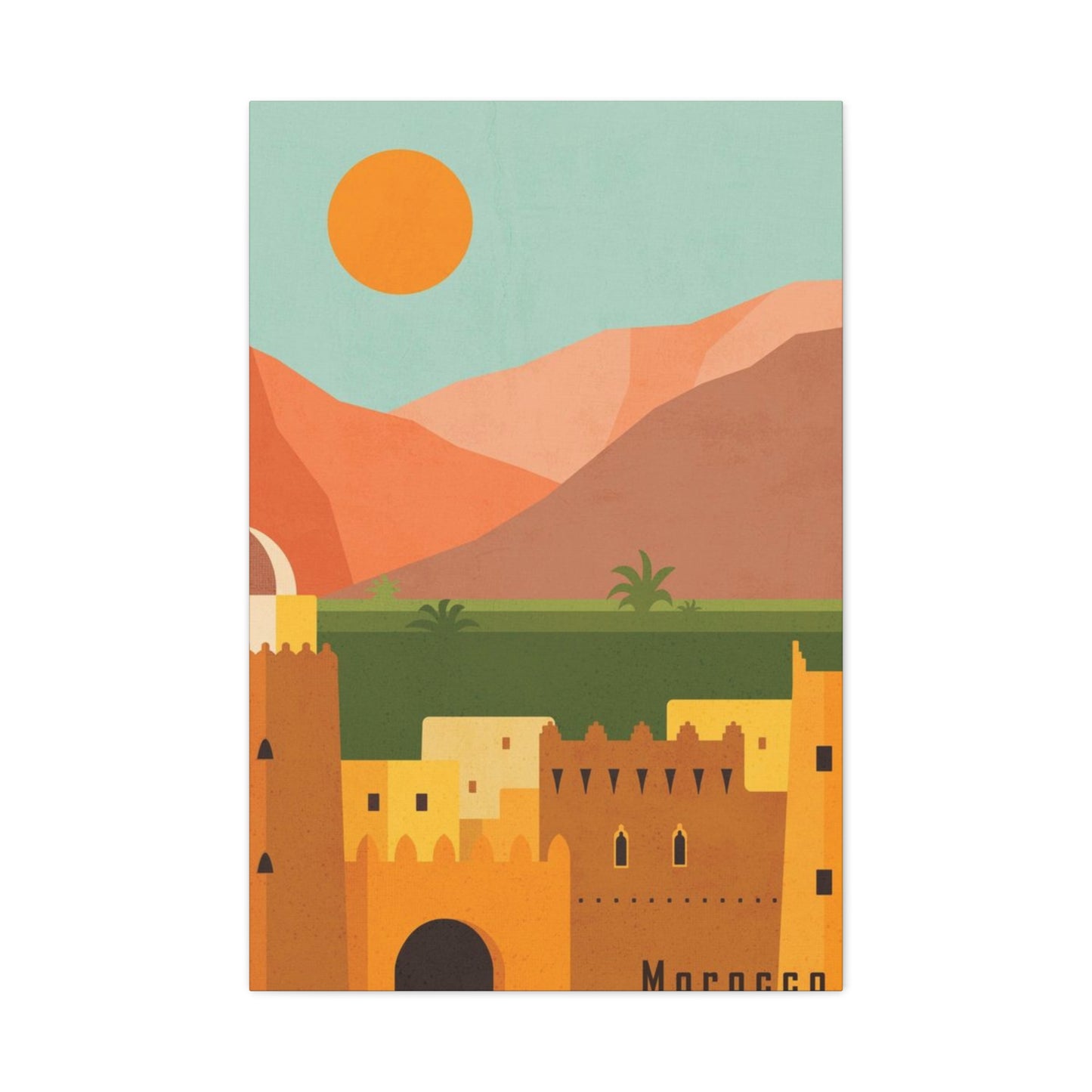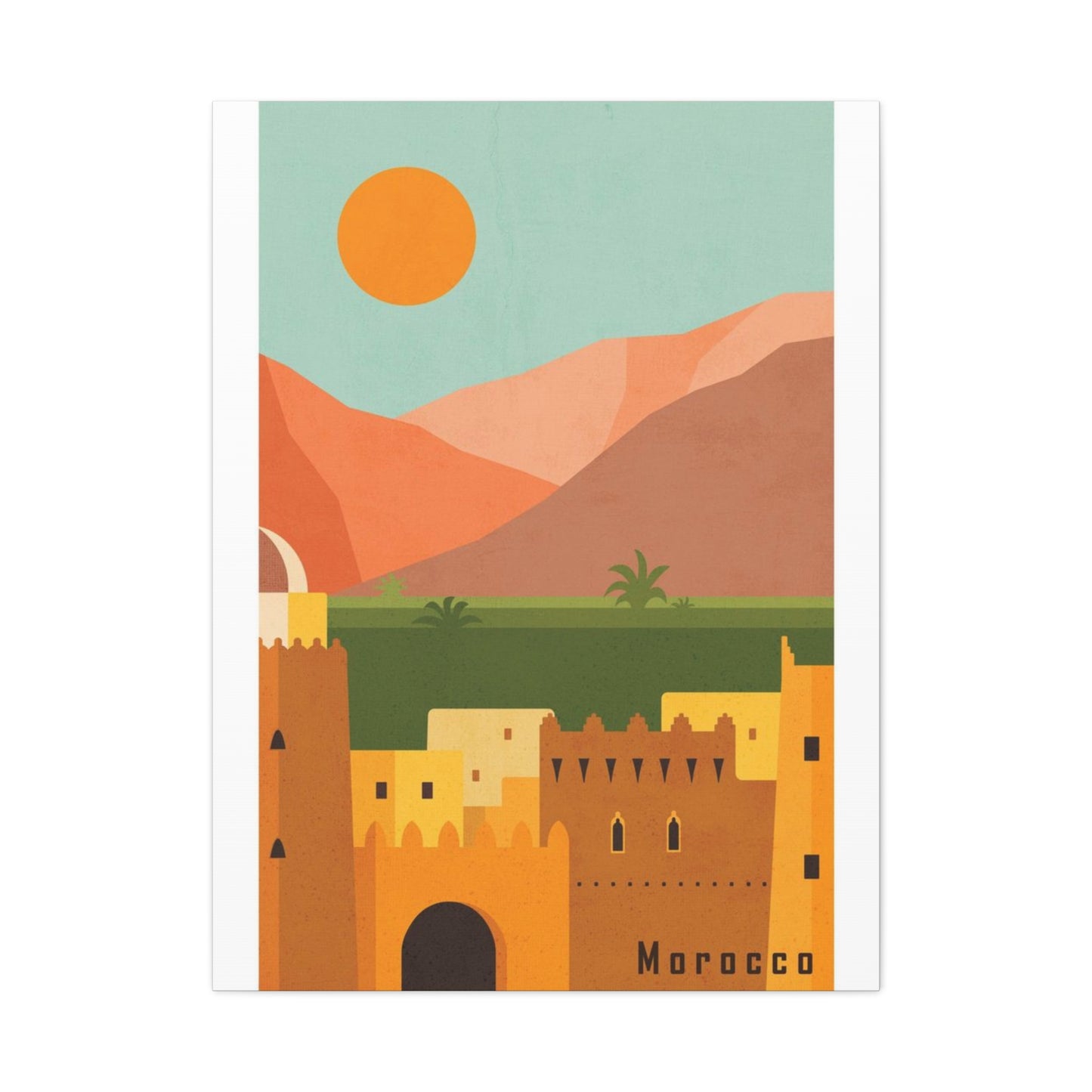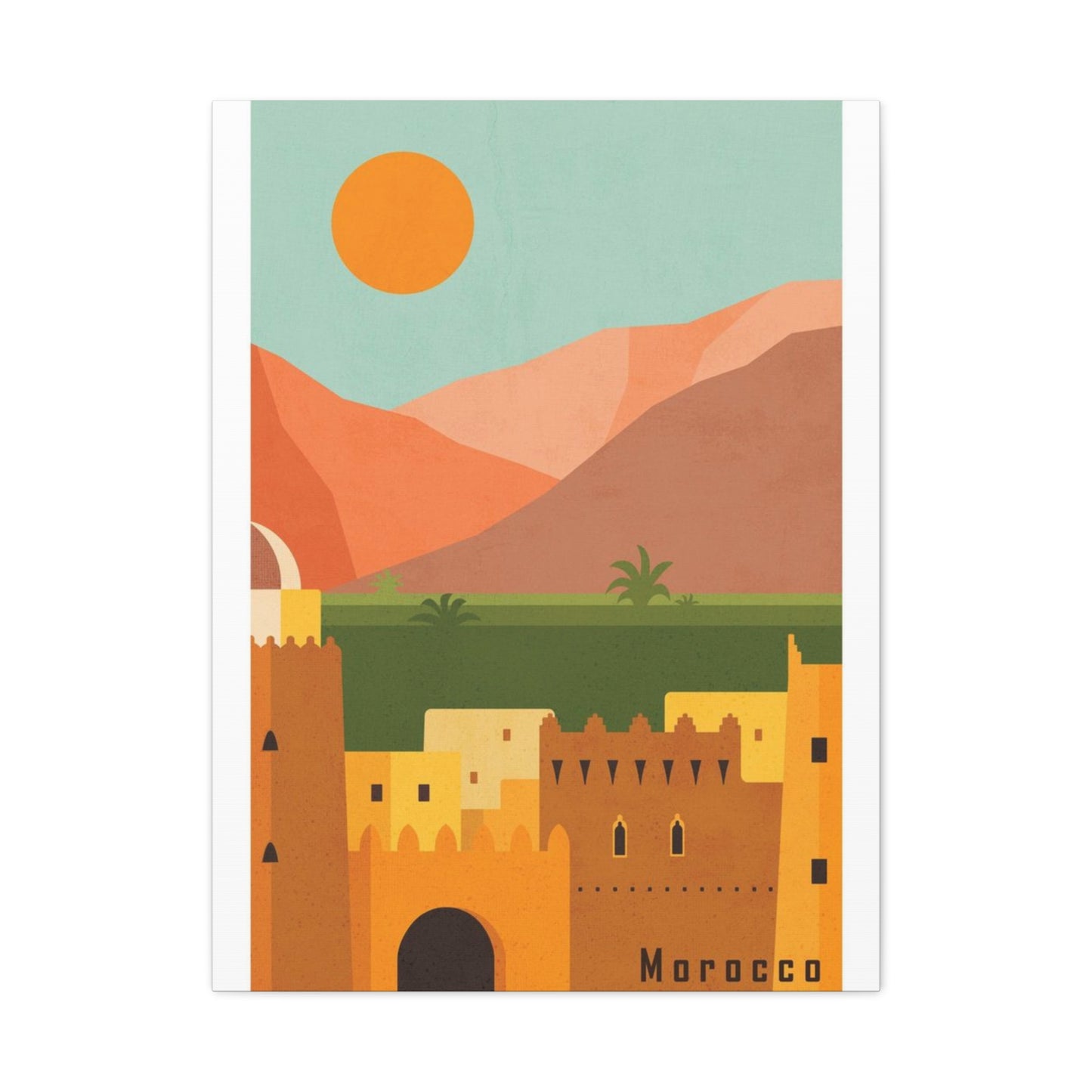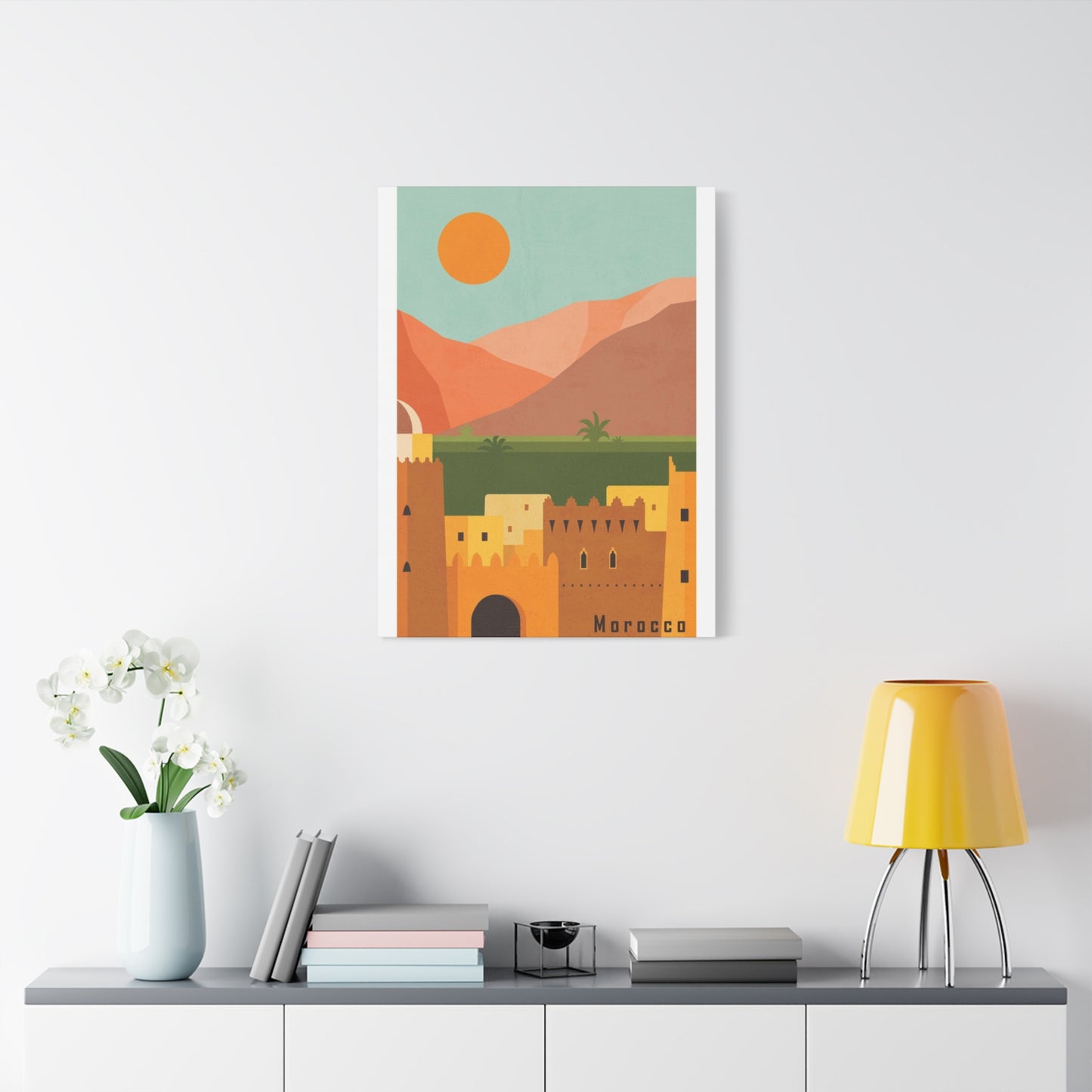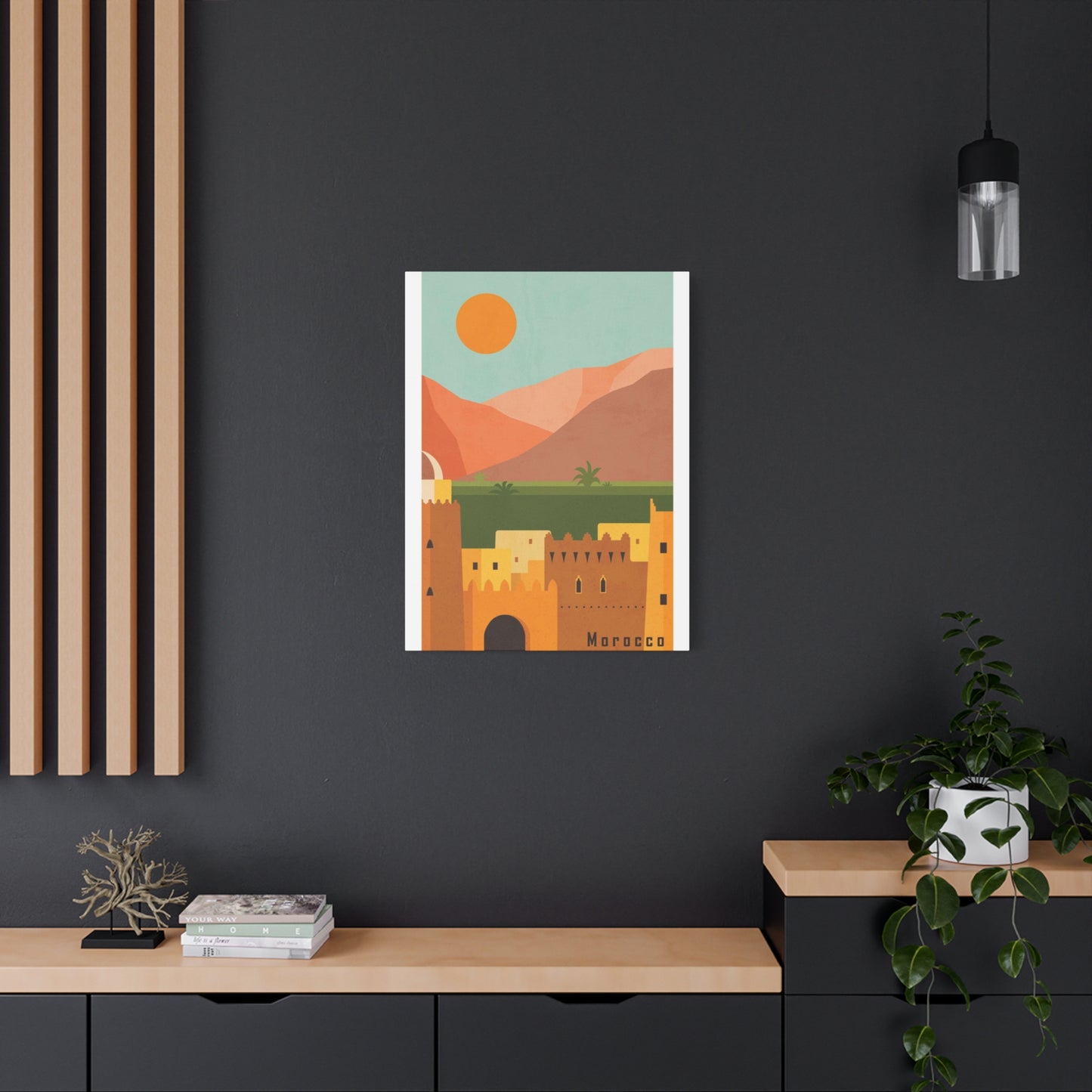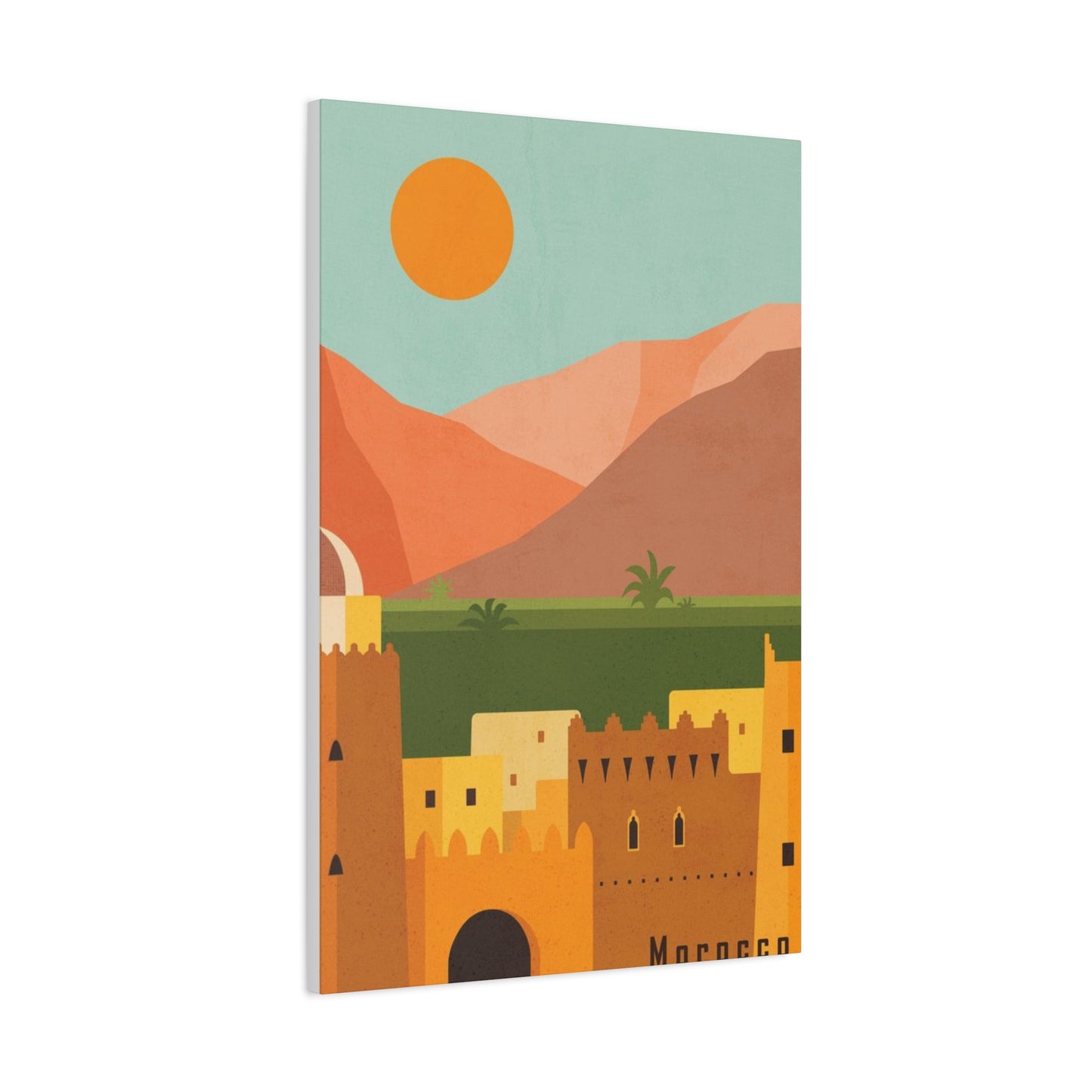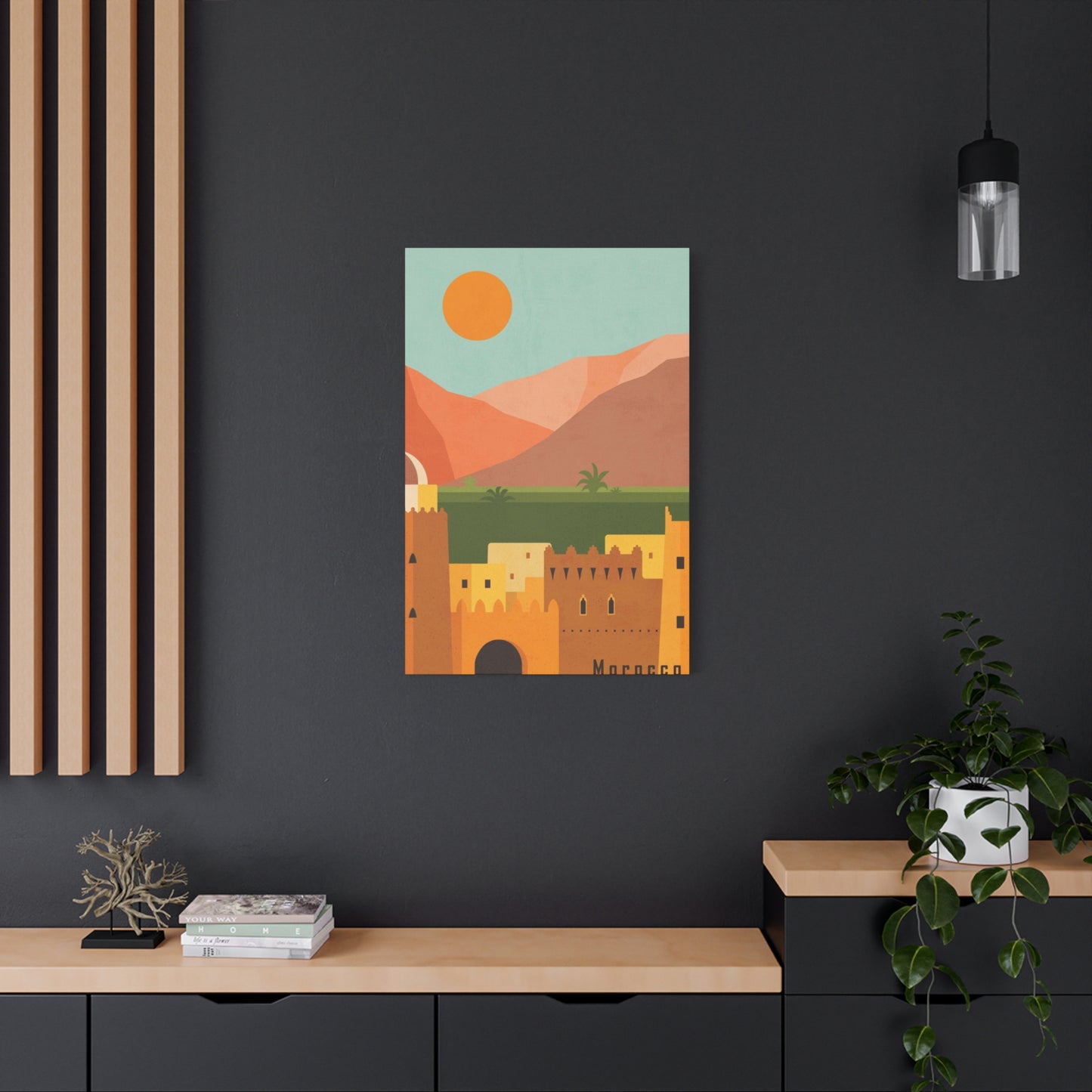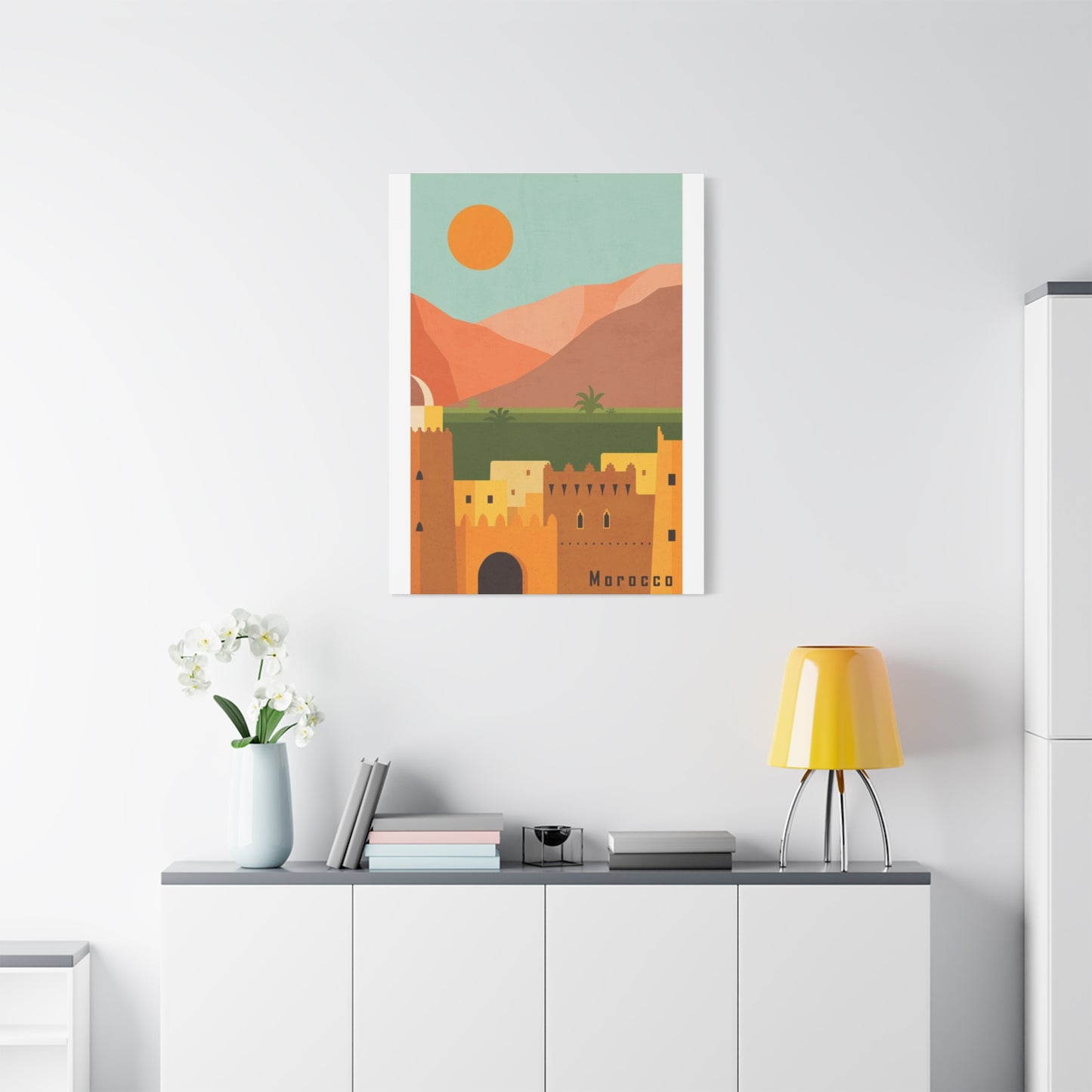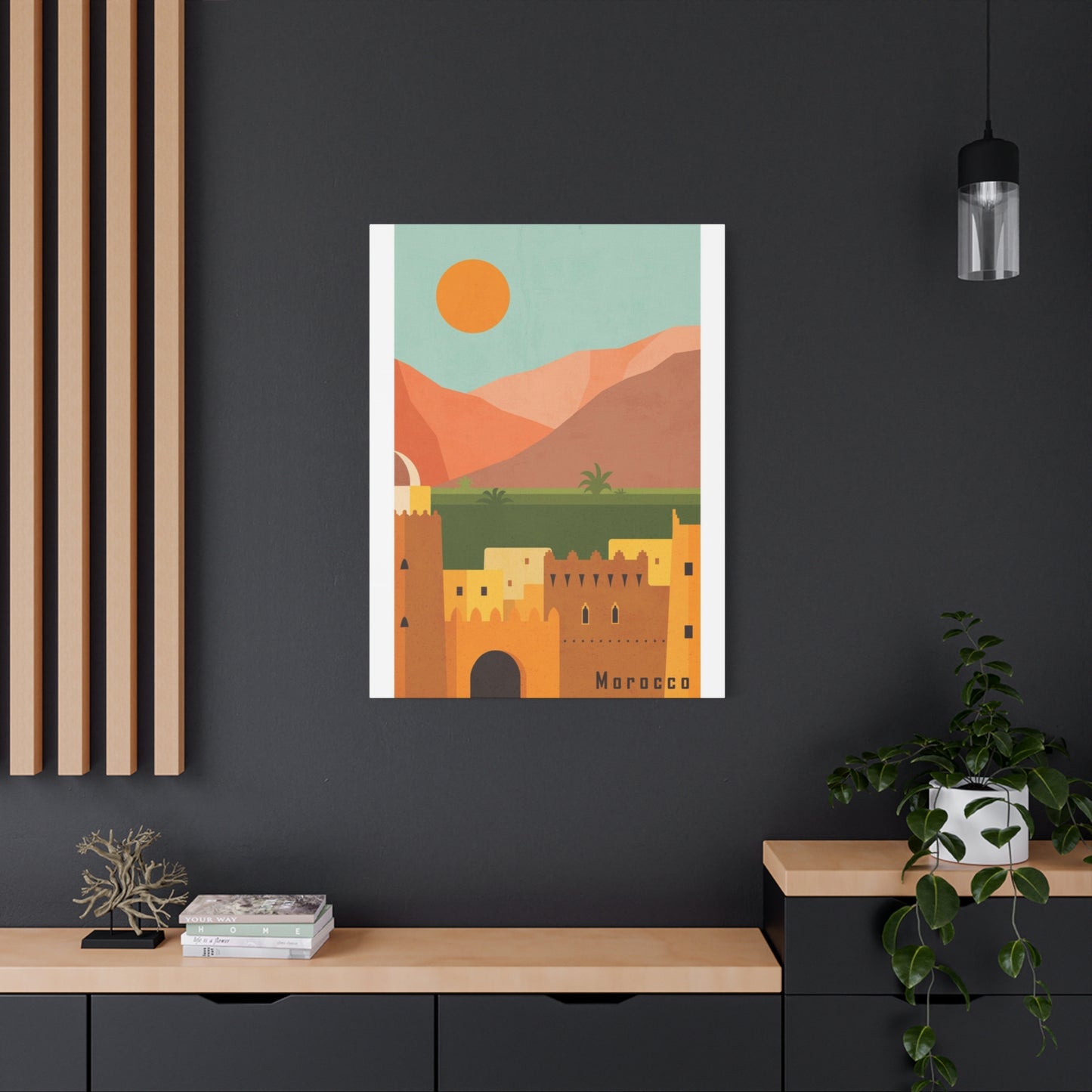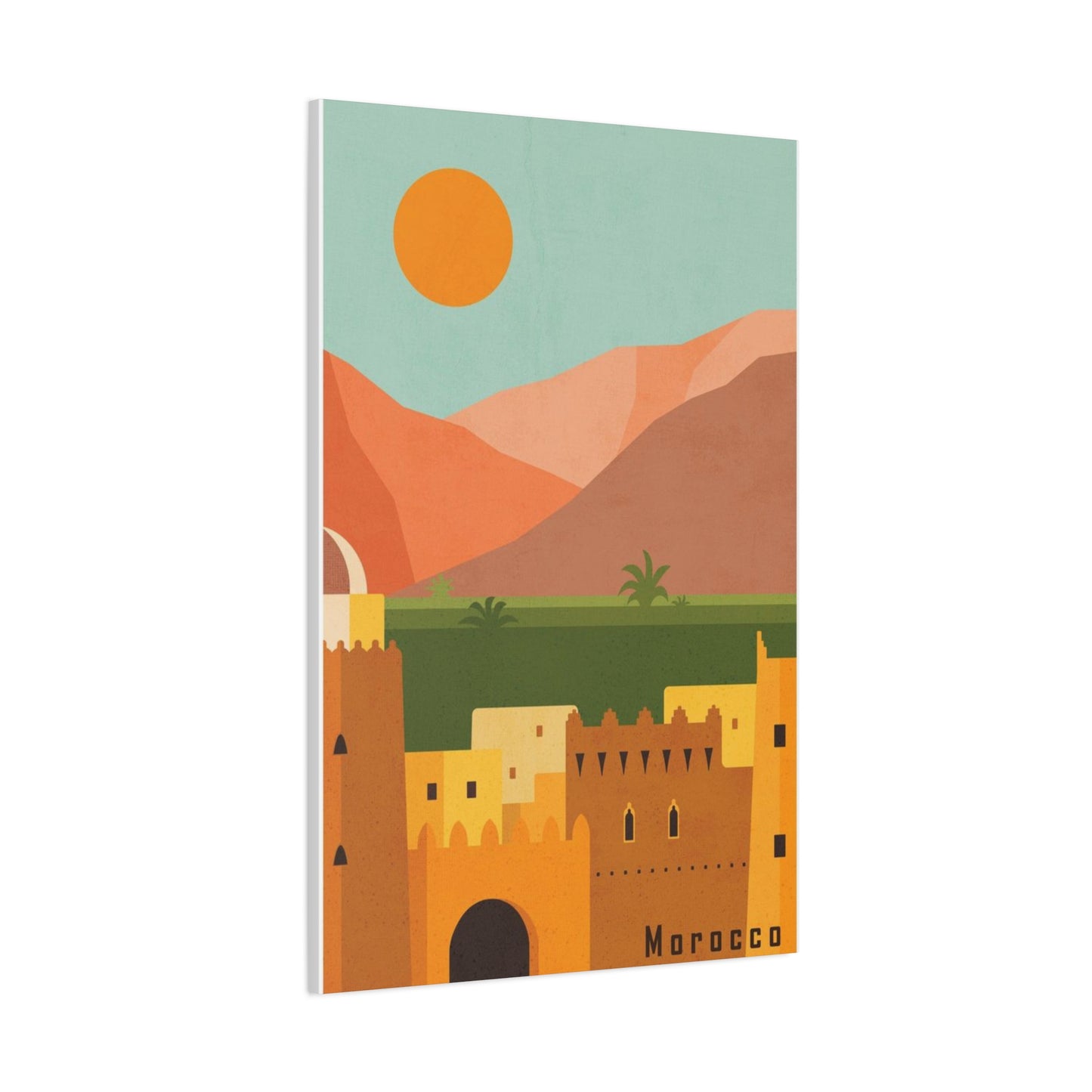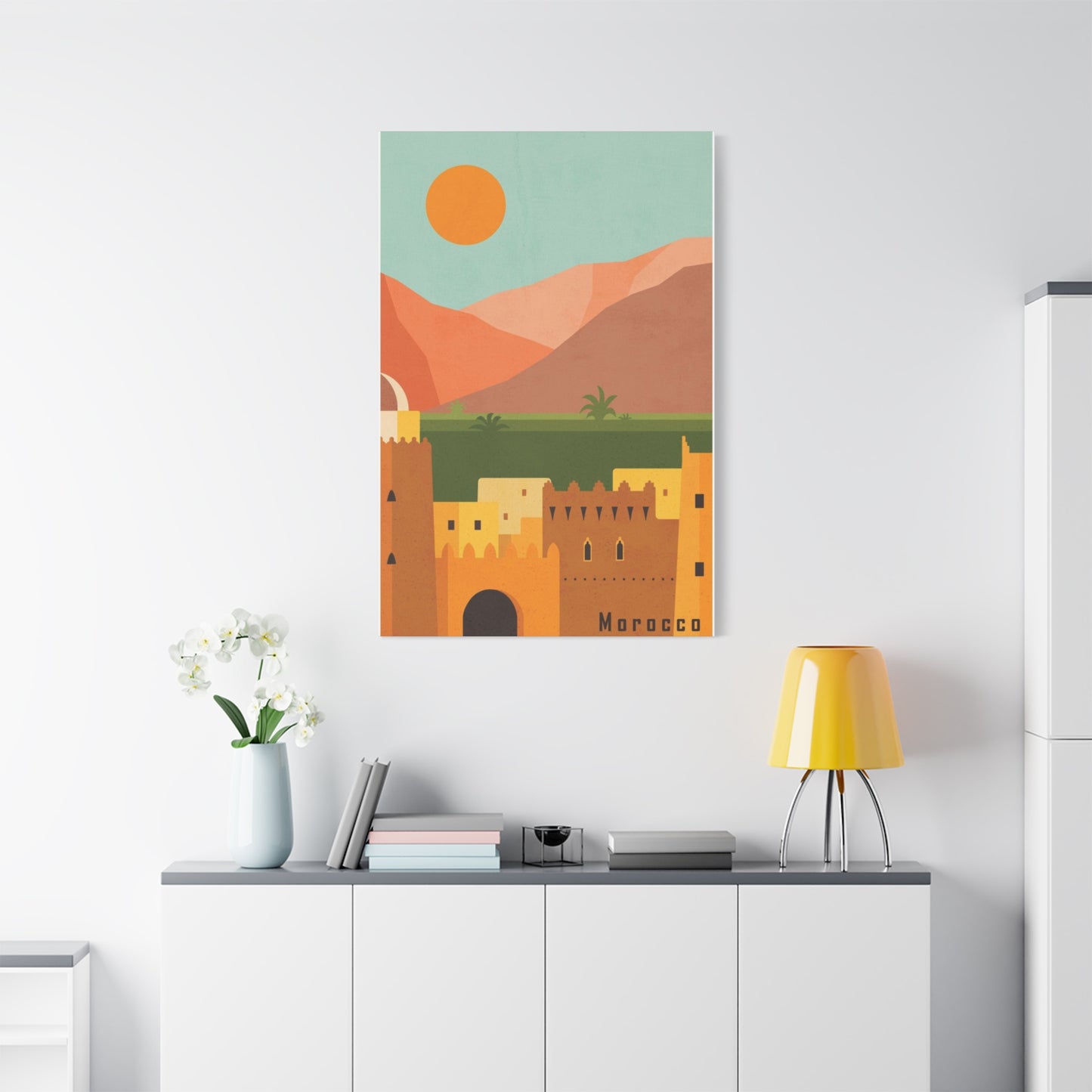Marrakech to Casablanca: A Complete Guide to Decorating with Moroccan City Canvas Art
The mesmerizing allure of North African urban landscapes has captivated art enthusiasts and interior designers worldwide, bringing the vibrant essence of ancient medinas, bustling marketplaces, and architectural marvels into modern living spaces. The growing fascination with North African-inspired decorative pieces reflects a broader appreciation for cultural diversity and the timeless beauty found in historic urban environments. These artistic representations offer more than mere decoration; they serve as windows into a rich cultural heritage that spans centuries of tradition, craftsmanship, and architectural brilliance.
When considering transformative elements for residential or commercial spaces, few options provide the dramatic impact and cultural depth offered by thoughtfully curated artistic interpretations of North African metropolitan areas. The interplay of warm terracotta tones, brilliant azure blues, sun-bleached whites, and rich ochre hues creates visual compositions that immediately transport viewers to distant lands filled with exotic spices, intricate tilework, and labyrinthine alleyways. This comprehensive exploration delves into every aspect of incorporating these captivating visual elements into contemporary interiors, from understanding their cultural significance to selecting pieces that harmonize perfectly with existing décor schemes.
The artistic representation of North African urban environments encompasses diverse styles ranging from photorealistic depictions to abstract interpretations, each offering unique aesthetic advantages. Whether drawn to the geometric precision of traditional architectural elements or the organic chaos of crowded marketplaces, these decorative pieces provide endless possibilities for personal expression and spatial transformation. The following extensive guide examines multiple facets of this artistic genre, offering detailed insights into selection criteria, placement strategies, cultural context, and the transformative power these pieces hold for residential and commercial environments alike.
Artistic Representations of North African Urban Landscapes
The artistic interpretation of North African metropolitan areas represents a fascinating intersection of documentary photography, impressionistic painting, and contemporary design sensibilities. These visual representations capture the unique atmosphere of ancient settlements where centuries-old traditions continue thriving amid modern developments. The narrow passages of historic quarters, with their overhanging balconies and intricately carved wooden doors, provide endless inspiration for artists seeking to convey the essence of timeless urban environments. The interplay of light and shadow across whitewashed walls, the geometric patterns adorning traditional buildings, and the vibrant textiles displayed in open-air markets all contribute to the distinctive visual character that makes these artistic pieces so compelling.
Creating effective artistic interpretations requires deep understanding of architectural principles, cultural symbolism, and compositional balance. Artists working in this genre must navigate the challenge of representing complex three-dimensional spaces on two-dimensional surfaces while maintaining the emotional resonance and atmospheric qualities that make these locations so captivating. The most successful pieces manage to convey not just visual information but also sensory experiences—the warmth of afternoon sun on ancient stone, the aromatic complexity of spice markets, the rhythmic sounds of craftspeople at work in traditional workshops. This multi-sensory quality transforms simple decorative pieces into immersive experiences that engage viewers on multiple levels.
The technical execution of these artistic works varies considerably depending on the chosen medium and artistic approach. Photographic representations offer documentary precision, capturing architectural details and street scenes with clarity that allows viewers to appreciate intricate tilework patterns, weathered textures, and the play of natural light across building facades. Painted interpretations provide greater artistic freedom, enabling creators to emphasize particular color palettes, simplify complex compositions, or introduce stylistic elements that enhance emotional impact. Digital art techniques combine advantages of both approaches, allowing for precise control over composition while maintaining flexibility to adjust colors, contrast, and atmospheric effects. The diversity of available styles ensures that collectors can find pieces perfectly suited to their aesthetic preferences and interior design requirements.
Understanding the cultural context enriches appreciation for these artistic works substantially. The urban landscapes depicted often represent centuries of architectural evolution, with layers of influence from various civilizations visible in building styles, decorative elements, and urban planning patterns. The characteristic blue-painted doorways and window frames seen throughout many North African cities carry symbolic significance related to spiritual protection and warding off negative influences. The intricate geometric patterns adorning building facades reflect mathematical principles and spiritual concepts fundamental to Islamic art traditions. Recognizing these deeper meanings transforms casual observation into meaningful engagement with cultural heritage, adding intellectual dimension to aesthetic appreciation.
Brilliant Canvas Representations of North African Metropolitan Areas
The translation of photographic images onto canvas substrate creates distinctive aesthetic qualities that elevate simple prints into gallery-worthy art pieces. Canvas material provides texture and depth absent from paper prints or poster-quality reproductions, lending physical presence that enhances visual impact considerably. The woven surface catches light differently than smooth materials, creating subtle variations in appearance as viewing angles change throughout the day. This dynamic quality keeps pieces visually interesting even after extended exposure, preventing the visual fatigue that sometimes accompanies flat, unchanging imagery. The substantial feel of properly stretched canvas over wooden frames communicates quality and permanence, signaling investment in meaningful décor rather than temporary decoration.
The selection of vibrant metropolitan imagery for canvas reproduction requires careful consideration of compositional elements, color intensity, and subject matter appeal. Successful pieces typically feature strong focal points that immediately capture viewer attention—perhaps an ornate doorway framing a glimpse of courtyard gardens, or a dramatic vista showcasing layered architecture against distant mountain ranges. The most compelling compositions balance complexity with clarity, offering enough visual interest to reward extended viewing while maintaining coherent overall structure that prevents overwhelming chaos. Color palettes prove particularly important, with the most effective pieces leveraging the warm, saturated hues characteristic of North African environments to create immediate emotional impact and atmospheric resonance.
Technical considerations in canvas production significantly affect final results and long-term durability. High-quality reproductions utilize archival inks resistant to fading from ultraviolet exposure, ensuring colors remain vibrant for decades rather than deteriorating within months. The canvas material itself should be acid-free and properly primed to prevent degradation over time. Stretching techniques matter considerably, as improperly tensioned canvas may develop wrinkles or sag after environmental changes. Gallery-wrap stretching, where the image continues around canvas edges rather than ending at frame boundaries, creates cleaner aesthetic lines and eliminates the need for additional framing, though traditionally framed presentations offer their own advantages depending on interior design contexts. Understanding these technical factors helps consumers make informed purchasing decisions that balance aesthetic preferences with practical longevity concerns.
The psychological impact of displaying vibrant urban imagery extends beyond simple aesthetic pleasure. Research in environmental psychology demonstrates that visual art significantly influences mood, stress levels, and overall sense of wellbeing within interior spaces. Images featuring warm color palettes tend to create welcoming, energizing atmospheres that encourage social interaction and creative thinking. The complex visual interest provided by detailed architectural scenes engages cognitive processes in ways that simple, minimalist designs cannot, offering mental stimulation that combats monotony in frequently occupied spaces. The cultural exoticism of North African imagery introduces elements of adventure and worldliness, potentially inspiring viewers toward broader cultural exploration and appreciation. These psychological dimensions make canvas prints functional elements contributing to occupant wellbeing rather than merely decorative accessories.
The versatility of canvas prints accommodates diverse interior design schemes and architectural contexts. Large-format pieces create dramatic focal points suitable for spacious living areas, executive offices, or hospitality environments seeking to establish distinctive character. Medium-sized works complement bedroom settings, dining areas, or professional waiting rooms where visual interest matters but should not dominate. Smaller canvas pieces work beautifully in galleries of coordinated images, bathroom accents, or narrow hallways where space constraints limit options. The relatively lightweight nature of stretched canvas compared to framed glass-fronted prints simplifies installation while reducing concerns about wall damage from heavy hanging fixtures. This practical advantage makes canvas particularly suitable for rental properties or spaces where permanent installation proves problematic.
Urban Landscape Decorative Elements from North Africa
The decorative potential of North African urban landscape imagery extends far beyond conventional wall art applications, encompassing diverse formats and installation approaches that suit various spatial requirements and design objectives. Understanding the full spectrum of available options enables designers and homeowners to make strategic choices that maximize aesthetic impact while respecting practical constraints. The term decorative elements encompasses not only traditional framed prints but also innovative formats including metal prints, acrylic panels, fabric tapestries, and three-dimensional installations that bring architectural elements into physical spaces rather than merely representing them visually.
Traditional framed presentations offer advantages in formal settings where conventional elegance takes priority. Quality framing protects artwork from environmental damage while providing visual boundaries that help integrate pieces into existing décor schemes. Frame selection dramatically affects overall impression, with ornate metalwork complementing traditional interiors while sleek minimalist frames suit contemporary spaces. Matting choices influence perceived scale and focus attention on central imagery, though many modern applications omit mats entirely for cleaner, more immediate visual impact. The glass or acrylic glazing protects prints from dust, moisture, and physical contact, particularly important in high-traffic areas or environments prone to cooking odors and humidity fluctuations. Understanding framing options and their implications helps consumers select presentations that enhance rather than detract from core imagery.
Metal print technology transfers photographic images onto specially coated aluminum sheets, creating luminous, almost three-dimensional visual effects particularly well-suited to architectural photography. The metallic substrate intensifies colors and creates subtle reflective qualities that change with lighting conditions and viewing angles. The durability of metal prints exceeds that of traditional materials, resisting fading, moisture damage, and physical wear while requiring minimal maintenance. The contemporary aesthetic of frameless metal prints appeals to modernist sensibilities and complements industrial-inspired interiors featuring exposed materials and minimalist design principles. These characteristics make metal prints excellent choices for contemporary office environments, upscale hospitality settings, or residential spaces embracing cutting-edge design trends.
Acrylic panel presentations create stunning depth and color saturation by mounting prints behind transparent acrylic sheets that function as both protective glazing and visual enhancement. Light passes through the acrylic and reflects off the print surface, creating luminosity impossible to achieve with traditional framing methods. The substantial physical presence of thick acrylic panels communicates luxury and investment in quality, making them particularly suitable for executive offices, upscale retail environments, or residential spaces where art serves as status symbol as well as aesthetic enhancement. The seamless, frameless edges of acrylic presentations create floating appearances when mounted with standoff hardware, adding sculptural dimension to inherently two-dimensional imagery.
Fabric-based presentations including tapestries and textile prints offer softness and texture that hard-surface options cannot match. These applications prove particularly valuable in spaces where acoustic dampening matters, as fabric absorbs sound rather than reflecting it like rigid surfaces. The organic draping qualities of textile presentations create relaxed, bohemian aesthetics particularly appropriate for bedroom environments, meditation spaces, or casual gathering areas. Some textile applications incorporate traditional weaving techniques that reference North African craft traditions, creating meta-textural connections between subject matter and presentation method. The relative affordability of textile options makes them accessible entry points for consumers hesitant to invest substantially in wall décor while still desiring significant visual impact.
The Essence and Energy of North African Metropolitan Artistic Expression
Capturing the distinctive spirit and energy of North African urban environments requires more than technical proficiency with photographic or painting equipment. Successful artistic representations convey intangible qualities—the particular quality of light filtering through palm fronds, the sense of ancient history pervading narrow passageways, the vibrant human energy animating crowded marketplaces. These atmospheric elements transform documentary representations into evocative artworks that transport viewers beyond mere visual observation into emotional and sensory engagement. Understanding what constitutes the essential spirit of these environments helps consumers select pieces that resonate on deeper levels than simple aesthetic appeal.
The play of light constitutes perhaps the most defining characteristic of North African urban environments, with intense sunlight creating dramatic contrasts between brilliantly illuminated surfaces and deep shadows. The clarity of desert air enhances color saturation, making even faded paint and weathered materials appear vivid. Artists successfully capturing this quality often emphasize tonal contrasts and warm color temperatures that evoke the particular luminosity of North African light. The direction and quality of light changes dramatically throughout the day, creating entirely different moods in identical locations—the soft golden glow of early morning, the harsh brilliance of midday, the warm amber tones of late afternoon. Artworks that successfully convey specific lighting conditions offer not just spatial representation but temporal specificity that enhances narrative dimension.
The human dimension proves equally essential to authentic representation of urban environments. The cities depicted in these artworks remain living, functioning communities rather than museum exhibits or abandoned ruins. The presence of residents going about daily activities—merchants arranging goods, craftspeople practicing traditional trades, children playing in narrow streets, elders conversing in shaded courtyards—breathes life into architectural documentation. Even when human figures do not appear directly in compositions, evidence of human presence through hanging laundry, open doorways revealing interior glimpses, or goods displayed for sale maintains connection to lived experience. This human element prevents sterile documentation and maintains emotional accessibility that allows diverse viewers to find personal connection points within unfamiliar cultural contexts.
The layering of historical periods creates visual and conceptual richness that distinguishes North African urban landscapes from more homogeneous built environments. A single street scene might include Roman-era stone foundations, medieval Islamic architectural elements, colonial-period modifications, and contemporary interventions all coexisting in complex palimpsest. This temporal layering manifests visually through varied building materials, contrasting architectural styles, and the accretion of repairs and modifications that tell stories of continuous habitation over centuries. Artists attuned to these historical dimensions can create compositions that function as visual archaeology, inviting viewers to trace threads of cultural evolution through architectural details and urban planning patterns. This intellectual dimension adds scholarly interest alongside aesthetic appeal.
The architectural vocabulary of North African cities reflects functional adaptations to challenging environmental conditions—intense heat, limited water resources, periodic sandstorms—that have shaped building traditions over millennia. Thick walls provide thermal mass that moderates interior temperatures, small windows limit heat gain while maintaining privacy, and flat roofs create additional living spaces while facilitating water collection during infrequent rains. Understanding these functional origins enriches appreciation of aesthetic features that might otherwise seem arbitrary decorative choices. The distinctive forms emerge from centuries of trial and error optimizing comfort and resource efficiency, representing accumulated wisdom of countless generations. This functional beauty where form directly serves purpose adds dimension beyond superficial prettiness to create genuinely meaningful design.
Historic Quarter Urban Scene Canvas Reproductions
The ancient residential and commercial districts forming the hearts of traditional North African cities provide particularly compelling subject matter for artistic representation. These dense, labyrinthine neighborhoods preserve architectural traditions and urban patterns dating back centuries, offering visual complexity and historical authenticity impossible to find in modern developments. The narrow passages barely wide enough for two people to pass, the overhanging upper stories creating tunnel-like enclosures, the sudden openings into hidden courtyards and squares—these spatial characteristics create inherently dramatic compositions that translate beautifully to two-dimensional artistic media. The wealth of architectural detail rewards close examination, making pieces suitable for extended contemplation rather than mere casual glancing.
The distinctive architecture of historic quarters reflects both practical considerations and aesthetic preferences that evolved over centuries. The enclosed, inward-facing design of traditional residences prioritizes family privacy while providing protected courtyards that serve as private outdoor spaces shielded from public view. This architectural approach creates visual mysteries in street scenes, where blank exterior walls and closed doors conceal elaborate interiors, inviting viewer imagination to complete what remains hidden. Occasional glimpses through partially open doorways or gates tease with revelations of interior gardens, tiled fountains, and richly decorated reception rooms, creating narrative tension between public and private realms. Artists effectively utilizing this tension create compositions that engage viewers' curiosity and imagination beyond what explicitly appears in the image.
The decorative elements adorning buildings in historic quarters represent centuries of craftsmanship tradition and artistic development. Intricate geometric patterns carved into wooden doors, colorful ceramic tiles arranged in complex mathematical designs, wrought iron window grilles incorporating flowing organic forms—these details demonstrate the high value traditional societies placed on beauty in everyday environments. Even modest structures often feature decorative elements that would be considered luxury in contemporary contexts, reflecting different cultural priorities about resource allocation and the importance of aesthetic experience in daily life. Reproducing these details with sufficient clarity to allow appreciation requires high-resolution photography and quality reproduction processes that preserve fine detail rather than reducing everything to indistinct blur.
The color palettes characteristic of historic quarters result from combinations of natural building materials, climate-responsive painting practices, and cultural color symbolism. The prevalence of earth tones—ochre, sienna, umber—reflects the use of local clay and stone materials that harmonize naturally with surrounding desert landscapes. The frequent application of white lime wash to building exteriors serves practical purposes by reflecting solar radiation and reducing heat absorption while creating visual brightness that offsets dark, narrow passageways. The strategic use of vibrant blues and greens on doors and window frames provides visual punctuation while carrying symbolic meanings related to spiritual protection and prosperity. Understanding these color choices as functional and symbolic rather than arbitrary aesthetic decisions adds layers of meaning to visual appreciation.
The evolving character of historic quarters as they adapt to contemporary life creates interesting tensions between preservation and progress. Some areas maintain remarkable architectural integrity, appearing superficially unchanged from centuries past despite modern amenities hidden behind traditional facades. Other districts show more obvious signs of contemporary intervention through satellite dishes, electrical wiring, modern shop signs, and structural modifications to accommodate vehicles in spaces designed for pedestrians and pack animals. Artists must decide how to address these contemporary elements—faithfully documenting mixed realities, selectively emphasizing traditional elements while minimizing modern intrusions, or embracing hybrid character as authentic representation of living culture rather than frozen museum exhibit. These artistic choices significantly affect the emotional tone and temporal ambiguity of final compositions.
Metropolitan North African Artistic Interpretations for Interior Enhancement
The integration of North African urban imagery into interior design schemes requires thoughtful consideration of scale, placement, color coordination, and thematic coherence with existing décor elements. Successful incorporation enhances overall aesthetic impact while avoiding jarring disconnects between artistic content and surrounding environment. Understanding principles of interior design helps maximize the transformative potential of these artistic pieces while avoiding common pitfalls that diminish rather than enhance spatial quality. The following examination of strategic approaches provides practical guidance applicable to diverse residential and commercial contexts.
Scale selection represents perhaps the most critical decision affecting visual impact and spatial integration. Oversized pieces create dramatic focal points that immediately command attention upon room entry, establishing clear hierarchy in visual importance among décor elements. Such statement pieces work best in spacious areas with adequate viewing distances allowing observers to appreciate entire compositions without physical backing away. Conversely, undersized artwork in large spaces appears timid and fails to achieve necessary visual weight, creating unfortunate impression of inadequate commitment to décor quality. The most effective approach matches print dimensions to wall proportions and room scale, ensuring pieces feel appropriately sized for their context rather than obviously too large or frustratingly small.
Placement height significantly affects viewing comfort and composition effectiveness. The standard recommendation positioning art center at approximately eye level applies in most contexts but requires adjustment for specific situations. In dining areas, lower placement accommodates seated viewing positions during meals. In stairwell installations, center points should align with sightlines from landing positions rather than floor level. Above furniture pieces, adequate clearance prevents crowding while maintaining visual connection between related elements. The horizontal positioning relative to room features like windows, doorways, and architectural details affects compositional balance and flow, with thoughtful placement creating harmonious relationships rather than awkward competitions for attention.
Color coordination between artwork and surrounding décor prevents clashing combinations while creating intentional harmonies that enhance cohesion. Three primary approaches offer different advantages depending on existing color schemes and desired effects. Complementary approaches pair artwork colors with opposite hue wheel positions in existing décor, creating vibrant contrast and dynamic energy. Analogous approaches select artwork featuring colors adjacent to dominant room hues, producing harmonious blending and smooth visual flow. Neutral backgrounds with selective color accents allow artwork to provide primary color interest without competing against strongly colored walls or furnishings. Understanding these color theory principles helps non-designers make effective choices that professional interior designers would recognize as sophisticated.
Lighting considerations dramatically affect artwork appearance and should inform both piece selection and placement decisions. Natural light varies throughout the day in both intensity and color temperature, potentially causing dramatic appearance changes between morning and evening viewing. Direct sunlight causes accelerated fading in most print media and creates glare that obscures detail, making light-controlled placement essential for preservation and optimal viewing. Artificial lighting offers consistency but requires appropriate fixture selection and positioning to illuminate artwork evenly without creating hot spots or shadow patterns. Gallery lighting techniques using directed spotlights create museum-quality presentation that emphasizes artwork importance while introducing dramatic lighting effects into overall room ambiance. The increasing availability of adjustable color-temperature LED systems allows fine-tuning lighting to enhance specific artwork color palettes throughout the day.
Thematic coordination with existing décor styles ranges from literal matching to abstract conceptual connections that require more sophisticated visual thinking. In spaces already featuring North African or broadly Mediterranean design elements—perhaps through furniture selections, textile patterns, or architectural details—urban landscape imagery creates obvious coherence through direct cultural connection. In more eclectic environments, thematic links might focus on shared color palettes, geometric pattern relationships, or abstract qualities like warmth and vibrancy rather than specific cultural identification. Modernist interiors might initially seem incompatible with traditional architectural imagery, yet thoughtful selection of graphic, geometric compositions can create surprising synergies between contemporary sensibilities and ancient architectural forms. The intellectual flexibility to recognize non-obvious connections enables creative integration that transcends superficial style matching.
Energetic North African Metropolitan Canvas Artwork
The particular vibrancy associated with North African urban scenes results from multiple factors working in combination—intense natural light, saturated architectural colors, bustling human activity, and the visual complexity of densely developed spaces. Artwork successfully capturing this characteristic energy creates immediate emotional impact, transforming neutral spaces into environments that feel alive and engaging. Understanding the specific elements that contribute to perceived vibrancy helps consumers identify pieces that will deliver desired energizing effects rather than merely depicting North African subjects without successfully capturing their essential character.
Color saturation levels dramatically affect perceived energy and emotional response to imagery. Highly saturated colors create excitement and demand attention, making spaces feel active and stimulating. More muted palettes produce calm, contemplative atmospheres suitable for relaxation and quiet reflection. North African urban environments naturally provide intense color through combination of bright sunlight enhancing natural pigment intensity and cultural preferences for strong, pure hues in architectural applications. Artists may further intensify colors beyond documentary accuracy to emphasize emotional impact, or they may reduce saturation for more subtle effects. Understanding personal preferences for color intensity helps guide selection toward pieces that will provide desired psychological effects in intended spaces.
Compositional dynamism contributes significantly to perceived energy beyond color considerations alone. Diagonal lines create movement and tension compared to stable horizontal and vertical orientations. Multiple focal points and complex visual pathways keep eyes moving around compositions rather than settling into static contemplation of single elements. Asymmetrical arrangements generate visual interest through tension between unequal elements, while symmetrical compositions create formal stability and calm. High contrast between light and dark areas produces drama and visual excitement, whereas subtle tonal variations create peaceful sophistication. Recognizing how these compositional elements affect emotional response enables strategic selection based on desired atmospheric qualities rather than vague, undirected aesthetic preferences.
Subject matter dramatically influences energy levels regardless of technical execution quality. Images featuring crowds of people engaged in various activities inherently convey more energy than empty architectural studies, though both have appropriate applications depending on desired effects. Market scenes packed with merchandise, interactions between vendors and customers, and colorful displays of textiles, spices, and crafts create maximum visual and implied kinetic energy. Quieter scenes of empty passageways or solitary figures in contemplation offer respite and calm. Urban vistas showing busy streets with visible movement through vehicles or pedestrians fall between these extremes. Matching subject matter energy to room function optimizes psychological impact—energizing artwork for social spaces and creative work areas, calming imagery for bedrooms and meditation spaces.
The size and scale of prints significantly affect their energetic impact independent of image content. Large format works create immersive experiences that surround viewers with depicted environments, producing strong emotional engagement and sense of transportation to represented locations. The sheer visual mass of substantial pieces generates presence that commands attention and establishes spatial character. Smaller works require closer, more intimate viewing that invites detailed examination but produces less immediate atmospheric impact. Gallery arrangements of multiple smaller pieces can achieve impressive collective impact while offering compositional flexibility impossible with single large works. Understanding these scale effects helps match artwork selections to both physical space characteristics and desired psychological outcomes.
The texture and surface qualities of print substrates contribute subtle but meaningful elements to overall vibrancy. Canvas textures add organic warmth and traditional art associations compared to smooth photographic papers. Metal prints create luminosity and contemporary edge. Textured specialty papers can enhance specific aesthetic qualities while adding tactile interest. Glossy finishes maximize color saturation and create reflective highlights, while matte surfaces reduce glare and produce sophisticated understatement. These surface qualities interact with image content in ways that either reinforce or counteract inherent characteristics, making substrate selection a meaningful creative decision rather than mere technical detail.
Architectural Features of North African Cities in Visual Art
The distinctive architectural vocabulary of North African urban environments provides rich visual material for artistic interpretation, combining functional design responding to environmental conditions with aesthetic traditions shaped by cultural values and artistic preferences. Understanding the key architectural elements characteristic of these environments enhances appreciation for artistic representations while providing framework for evaluating authenticity and quality. The following examination explores major architectural features frequently appearing in North African urban artwork and their cultural and functional significance.
The ubiquitous riads represent perhaps the most iconic residential architecture form throughout North African cities. These inward-facing houses organize all rooms around central courtyards, creating private outdoor spaces protected from street-level public view while maintaining connection to sky and natural light. The courtyard typically features a fountain or small pool providing visual and auditory pleasures while serving practical cooling functions through evaporation. Surrounding arcades supported by columns create covered circulation routes and semi-protected spaces transitioning between interior and exterior environments. Upper-story galleries allow air circulation while providing vantage points overlooking courtyard activities. Artistic representations of riad architecture emphasize these characteristic spatial organizations and decorative treatments that transform functional requirements into aesthetic experiences.
The monumental gates marking entrances to historic quarters and individual important buildings demonstrate sophisticated architectural ambitions combining defensive functionality with symbolic expression of power and hospitality. These elaborate structures often feature horseshoe arches, one of the most recognizable architectural elements associated with Islamic architecture in North Africa. The distinctive shape provides structural advantages while creating immediate visual identification with cultural traditions. Elaborate tilework, carved stone, and sculptural details transform these functional passages into artistic statements that announce the importance of spaces they protect. The scale of monumental gates provides impressive focal points for artistic compositions while their ornate details reward close examination and detailed representation.
Minarets rising above surrounding buildings serve religious functions as platforms for call to prayer while creating vertical punctuation in predominantly horizontal urban landscapes. The architectural treatment of these towers varies considerably across different regions and time periods, from austere square structures with minimal ornamentation to elaborate compositions featuring multiple decorative bands, carved stonework, and crowned by complex geometric pavilions. The vertical emphasis of minarets creates compositional anchors for artistic representations of urban skylines and provides scale references that emphasize the density and complexity of surrounding development. The symbolic significance of these structures adds layers of meaning beyond purely visual considerations.
The covered marketplaces called souks create fascinating architectural environments where functional commercial requirements meet sophisticated spatial organization and atmospheric control. The covered passages protect shoppers and merchants from intense sun while maintaining ventilation through strategic openings and venting. The repetitive rhythm of arched passages creates strong linear perspective that leads eyes deep into compositions, while the visual complexity of merchandise displays and human activities prevents monotony. The interplay of light filtering through various openings creates atmospheric effects that enhance the mysterious, exotic qualities these spaces hold for outside observers. Artistic representations of souk environments capture both architectural character and the vibrant commercial and social life these spaces support.
The decorative tilework called zellige represents one of the most visually striking architectural features throughout North African buildings. These intricate geometric patterns composed of individually cut and arranged ceramic pieces create complex mathematical designs that cover walls, floors, fountains, and architectural details. The labor-intensive production of zellige work demonstrates the high value traditional societies placed on elaborate decoration in both religious and secular buildings. The mathematical precision of geometric patterns reflects philosophical and spiritual concepts about divine order and the underlying structure of creation. The vibrant colors and visual complexity of zellige work provide concentrated areas of intense visual interest within architectural compositions, creating jewel-like focal points that draw and hold viewer attention.
The Major Atlantic Port Urban Decorative Elements
The largest city in the country represents a unique blend of traditional North African urban character with colonial-era European influences and contemporary international development. This complex layering creates distinctive visual character different from more historically preserved cities, offering artistic opportunities ranging from gleaming modern towers to weathered art deco buildings to traditional neighborhoods maintaining centuries-old patterns. Understanding the specific architectural and urban characteristics of this metropolitan area helps appreciate artwork depicting its unique environment and the choices artists make in representing this multifaceted urban landscape.
The monumental religious structure dominating the coastline represents one of the most significant architectural achievements of recent decades, combining traditional design vocabulary with modern construction technology and unprecedented scale. The immense tower rising above the main structure creates an unmistakable landmark visible throughout the city and from offshore vessels. The elaborate decorative treatments covering interior and exterior surfaces demonstrate traditional craftsmanship traditions applied at monumental scale. The relationship between this massive structure and surrounding cityscape creates dramatic visual compositions contrasting sacred and secular, traditional and contemporary, human scale and overwhelming monumentality. Artistic representations of this landmark range from documentary architectural studies to atmospheric evocations of its spiritual and cultural significance.
The preserved historic quarter maintains traditional urban character despite encroachment by modern development surrounding its perimeter. The dense network of narrow passages, traditional houses, and working craftspeople's shops provides authentic glimpses of urban life patterns predating modern transformation. The relatively modest scale of this historic area compared to the sprawling modern city creates interesting contrasts and raises questions about cultural preservation amid rapid change. Artists depicting this environment often emphasize its authentic traditional character while acknowledging the fragile, embattled quality of heritage preservation in rapidly modernizing contexts. The visual contrast between ancient weathered surfaces and vibrant contemporary interventions creates compositional opportunities highlighting tensions between past and present.
The distinctive art deco architecture from the colonial period creates a unique stylistic signature different from both traditional Islamic architecture and generic international modernism. The white facades, curved balconies, geometric decorative elements, and nautical references create sophisticated aesthetic that has gained appreciation as historical distance allows more objective evaluation of this period. The concentration of preserved art deco buildings in certain districts creates streetscapes unlike any other North African city, providing unique subject matter for artistic interpretation. The aging of these buildings—cracking paint, weathered details, patina of decades—adds visual interest and historical character that pristine new construction cannot match. Artists drawn to architectural documentation and urban archaeology find rich material in these transitional districts.
The contemporary waterfront development initiatives represent ambitious attempts to create international destination attracting tourism and investment through spectacular architecture and public spaces. The massive shopping and entertainment complexes, luxury hotels, and entertainment venues create dramatic skyline silhouettes particularly striking when photographed from coastal vantage points. The clean lines and massive scale of contemporary construction contrast dramatically with dense, complex character of traditional urban areas. Artists must decide whether to celebrate this modernization as legitimate cultural evolution or critique it as loss of authentic identity—decisions that significantly affect artwork tone and reception. The most interesting artistic responses acknowledge complexity rather than reducing debate to simplistic endorsement or rejection.
The continuing vitality of traditional commercial areas and residential neighborhoods despite modern competition demonstrates resilience of established urban patterns and cultural practices. The persistence of traditional craft production, marketplace commerce, and community social patterns in face of shopping mall convenience and automobile-centered development speaks to deep cultural continuity beneath surface modernization. Artists attentive to these subtleties can create works highlighting ongoing traditions rather than reducing subject matter to museum curiosities or nostalgic recreations of disappeared worlds. This attention to contemporary lived experience rather than historical fantasy creates more authentic and ultimately more interesting artistic statements about cultural identity in contexts of rapid change.
Spectacular North African Urban Sunset Canvas Reproductions
The dramatic lighting conditions during the transition from day to night create particularly stunning atmospheric effects in North African urban environments, combining the warm color palettes of architectural materials with the golden-to-crimson progression of sunset light. These ephemeral moments when sunlight strikes surfaces at extreme angles create transformative effects that reveal texture and form in ways flat midday illumination cannot match. Artistic representations capturing these fleeting conditions offer viewers access to moments of extraordinary beauty that, even for residents of depicted locations, occur only briefly each day under specific weather conditions.
The color temperature shifts during sunset transform familiar urban scenes into otherworldly visions where ordinary architecture glows with supernatural intensity. The warm amber tones of late afternoon gradually deepen into rich orange and eventually crimson as the sun approaches the horizon. These warm hues interact with inherently warm architectural color palettes—earth tones, terracotta, ochre—to create intensely saturated compositions that push boundaries between realistic documentation and fantastical vision. The contrast between illuminated surfaces still receiving direct sunlight and shaded areas already entering dusk creates dramatic tonal ranges that add visual excitement and compositional structure. Artists capturing these conditions offer viewers concentrated aesthetic experiences that condense the most visually spectacular moments while eliminating the mundane periods between dramatic lighting events.
The particular clarity of desert air in many North African locations enhances sunset effects by minimizing atmospheric diffusion that softens colors in more humid climates. The crystalline sharpness with which distant architectural features remain visible even at extreme distances allows sunset light to illuminate complex urban landscapes layers deep, creating extraordinarily rich visual compositions. The minimal haze means colors remain pure and saturated rather than washing out into pale pastels as often occurs in maritime or tropical environments. This environmental quality makes North African urban sunsets particularly suitable for photographic and artistic documentation, as captured images retain intensity and impact rather than serving as pale reminders of more impressive experiences that could not be adequately recorded.
The silhouetting effects as light fades create graphic compositions emphasizing building profiles and skyline character against luminous skies. As light levels drop, architectural details become less visible while overall forms become more prominent, creating simplified, almost abstract compositions that emphasize essential shapes over surface details. Minarets, towers, domes, and distinctive rooflines create recognizable profiles that identify specific locations even when detail disappears into shadow. The negative space of sky becomes increasingly important as positive element in composition rather than mere background, with subtle color gradations and cloud formations contributing significantly to overall aesthetic impact. Artists working with sunset conditions often emphasize these graphic qualities, creating bold, poster-like compositions with strong visual impact at any scale.
The fleeting nature of optimal sunset conditions adds value to successful artistic captures, as perfect combinations of clear skies, interesting cloud formations, and ideal atmospheric conditions occur only occasionally even in favorable locations. A photographer might visit a location dozens of times before conditions align for truly exceptional results. The sense that captured moments represent rare conjunctions of favorable circumstances adds to perceived value and artistic achievement. This ephemeral quality contrasts with architectural documentation possible under any neutral lighting condition, elevating sunset imagery into more rarified category requiring patience, luck, and readiness to capitalize on momentary opportunities.
The emotional associations of sunset imagery affect viewer response independent of specific subject matter or technical execution quality. Sunsets universally symbolize endings, transitions, and the poignant beauty of temporal passage. These associations add emotional depth to compositions that might otherwise function as purely visual documentation. The romantic and contemplative qualities associated with sunset viewing create expectation of aesthetic pleasure that predisposes viewers toward positive response. Artists leveraging these universal emotional connections create works that resonate across cultural boundaries even when depicting unfamiliar architectural environments, making sunset imagery particularly effective for reaching broad audiences without requiring specialized cultural knowledge.
Contemporary Existence in North African Urban Centers as Artistic Subject
The ongoing evolution of North African cities as living communities rather than preserved historical exhibits creates fascinating artistic opportunities and interpretive challenges. Modern life continues in ancient settings, creating complex layering of temporal periods and cultural influences that resist simple categorization or romantic idealization. Artists choosing to represent contemporary urban life rather than carefully edited historical fantasies engage with messy, complicated realities that reveal more about authentic cultural identity than sanitized tourist-friendly imagery typically permits. This commitment to honest representation creates artwork with greater depth and lasting interest than mere superficial prettiness.
The persistence of traditional economic activities and crafts despite competition from industrial manufacturing and imported goods demonstrates cultural resilience and continuing demand for handmade quality. The artisans working in traditional workshops using centuries-old techniques represent living links to cultural heritage, maintaining skills and knowledge that might otherwise disappear. Their presence in contemporary contexts rather than museum demonstrations acknowledges craft traditions as viable economic activities rather than quaint anachronisms. Artists documenting these practitioners honor their continuing relevance while creating records of practices that may not survive another generation of modernization pressures. The tools, materials, techniques, and finished products provide rich visual detail that communicates specific cultural knowledge while creating aesthetically compelling compositions.
Conclusion:
The Moroccan City Canvas Art collection, spanning from Marrakech to Casablanca, captures the vibrant essence, architectural splendor, and cultural richness of Morocco’s most iconic cities, transforming interior spaces into immersive experiences that celebrate both style and heritage. Each canvas brings the dynamic energy of bustling medinas, the geometric precision of ancient architecture, and the vivid interplay of color, light, and shadow to your walls. Beyond its decorative appeal, this collection functions as a narrative medium, inviting viewers to explore Morocco’s diverse landscapes, history, and urban vibrancy through contemporary artistic expression. By incorporating these pieces into modern interiors, homeowners can infuse their spaces with cultural depth, visual sophistication, and timeless elegance.
At the heart of Moroccan City Canvas Art is the seamless balance between realism and artistic interpretation. Artists skillfully capture cityscapes, courtyards, markets, and architectural landmarks, emphasizing perspective, proportion, and intricate detail. The use of vibrant hues—deep blues, warm terracottas, golden sunlight, and lush greens—reflects Morocco’s distinctive palette while creating visual harmony that enhances the overall aesthetic of a room. The combination of bold color, architectural forms, and atmospheric elements ensures that each canvas is not only visually captivating but also emotionally engaging, evoking the lively spirit, history, and mystique of Morocco’s urban centers.
From an interior design perspective, Moroccan city art offers both versatility and impact. Large-format canvases become striking focal points in living rooms, dining areas, or home offices, grounding the space with cultural richness and visual interest. Smaller canvases or grouped arrangements provide opportunities to curate gallery-style installations that guide viewers through a thematic journey of Moroccan cities, adding narrative cohesion and stylistic depth. The collection complements a wide range of décor styles, including modern, bohemian, eclectic, and traditional interiors, making it easy to integrate Moroccan charm while maintaining overall design coherence. The geometric and ornamental qualities of the architecture also harmonize beautifully with textured elements such as rugs, ceramics, and wooden accents, creating a unified, sophisticated space.
Lighting plays a critical role in enhancing the immersive qualities of Moroccan City Canvas Art. Ambient lighting softens shadows and accentuates the subtle gradients of architectural details, while directional or accent lighting highlights focal points, such as intricate arches, market scenes, or city landmarks. The interaction of light and shadow adds depth, dimension, and vibrancy to each piece, creating a dynamic viewing experience that evolves throughout the day. Properly illuminated, these canvases transform walls into living narratives, capturing the vibrancy and rhythm of Moroccan urban life.
Emotionally, the collection resonates because it transports viewers to the bustling streets, serene courtyards, and historic landmarks of Morocco. Each canvas evokes curiosity, wanderlust, and a sense of cultural connection, allowing homeowners to engage with Moroccan heritage and architectural beauty from the comfort of their homes. The artworks inspire conversation, contemplation, and appreciation for craftsmanship and design, fostering a sense of warmth, curiosity, and global sophistication. By bringing the colors, textures, and energy of Moroccan cities indoors, the collection elevates both the aesthetic and emotional atmosphere of a space.
Artistically, the canvases showcase mastery in composition, perspective, and color balance. Geometric patterns, arches, windows, and market layouts are rendered with precision and creativity, creating a harmonious interplay of detail and abstraction. The attention to texture, light, and atmospheric conditions adds realism while allowing for imaginative interpretation, ensuring that each piece engages viewers on multiple levels.

















